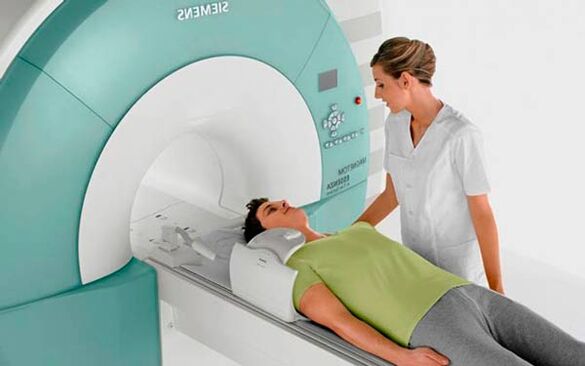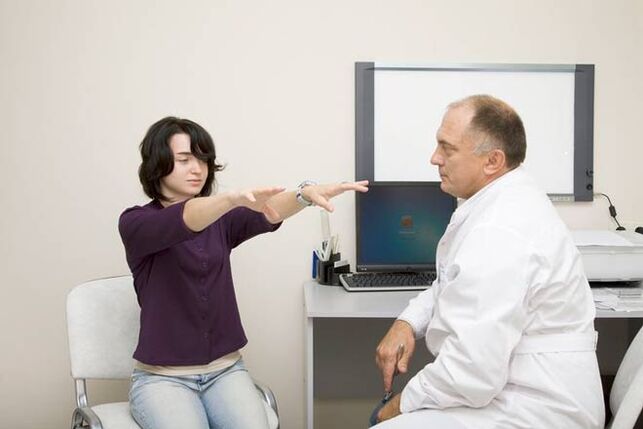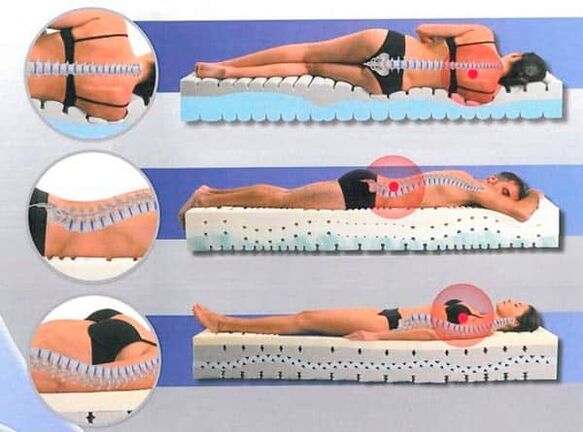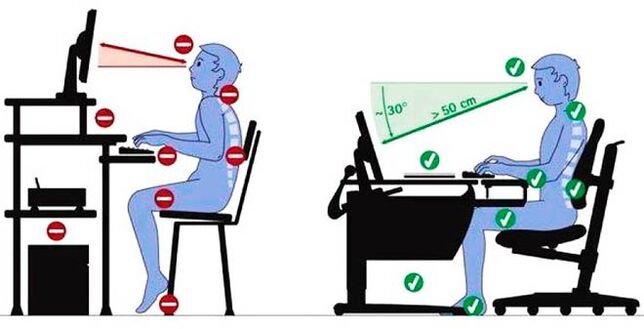Due to the relative inactivity and anatomical features, osteochondrosis rarely affects the thoracic region, but this disease cannot be considered rare. Therefore, if you feel stiffness and pain in the area of the shoulder blades, it is worth finding out what is osteochondrosis of the thoracic spine, what are its symptoms and treatment methods.
In fact, the disease is rarely localized in this part of the spine, but it brings unpleasant consequences and sensations nothing less than damage to the neck and lower back. Its peculiarity can be safely called "nebulization" of symptoms, in which even an experienced doctor can be confused at the beginning of the disease.
What is thoracic osteochondrosis?
Osteochondrosis: degenerative-dystrophic lesions of the discs between the vertebrae and the vertebrae themselves.
As already mentioned, the disease manifests itself in the thoracic region much less often than in the lumbar or cervical region due to such features:
- the thoracic region is inactive;
- it is well fixed by the ribs and the whole chest;
- Due to kyphosis (that is, the physiological flexion of the spine backwards) in the thoracic region, the vertebrae experience maximum stress in the more durable anterior part.
But, unfortunately, everyone can develop an ailment, especially if there are prerequisites for this.
What does an MRI of the thoracic spine show?
Diagnosis of a disease that has formed in the thoracic region must be made comprehensively, and MRI shows the true picture better than most studies.
How is an MRI done?
Everything is simple and painless: you need to lie on a bench, which enters a special spherical chamber, and wait the allotted time until the equipment "illuminates" the body. It is worth removing all metal objects in advance and warning the staff in case of the presence of pacemakers, prostheses and other foreign things in the body.
In general, osteochondrosis was previously diagnosed exclusively with the help of palpation: they probed the vertebrae, there is pain, which means that osteochondrosis is present. Now doctors supplement their knowledge with special studies, among them the most informative is magnetic resonance imaging, which allows to establish degenerative phenomena in cartilage and vertebrae, to determine the presence of hernias, the peculiarities of their development.
If you're not afraid of tight spaces, you can even take a nap.

Symptoms of osteochondrosis of the thoracic spine.
Symptoms of insidious osteochondrosis in the thoracic region can be successfully hidden for a long time, without manifesting themselves and without causing pain or even discomfort. And then, when the damage is already causing obvious manifestations, it is sometimes difficult to determine the source of the painful sensations - they can be transmitted to the heart, internal organs and legs. Therefore, it is necessary to analyze this issue in detail.
So, doctors distinguish several types of symptoms.
Reflexes are directly related to the negative effects of the disease on various receptors.
As a result, the patient feels:
- pain in the area of the shoulder blades or just below, often surrounding and squeezing "like a ring";
- the focus of pain can be localized in different parts of the body - in the sternum, simulating heart attacks, on the right side, disguising itself as a liver, and even in the lower back, as renal colic, therefore, when diagnosing, it It is often necessary to undergo a thorough examination of the internal organs to conclude that there is a problem in the back.
Compression symptoms appear due to compression or stretching of the nerve roots,
as a result, there may be:
- weakness in the legs, they seem to refuse;
- loss of sensation in the extremities;
- numbness in the pinched area, "goose bumps" feeling;
- comatose feeling in the chest;
- the tension of the surrounding muscles, which can be found when massaging;
- impairment in organ work, fortunately these neglected cases are rare.
Given the peculiarities of the physiology of women, sometimes the symptoms of osteochondrosis in the thoracic region are confused with other diseases.
Often the pain radiates to the mammary glands, which automatically makes the woman think of problems with her breasts.
The regular, pulling pains resemble fibrosis, tumors, and other problems with the gland, prompting you to run to a mammologist for a consultation. And if the doctor, after tests, examination and mammography, does not find any abnormalities in the structure and functioning of the mammary glands, the presence of osteochondrosis can be safely assumed.
Causes of osteochondrosis of the thoracic region.
The causes of osteochondrosis for the thoracic region and others are the same, but for the problem to be localized exactly here, clear prerequisites are needed:
- curvature of the spine, particularly of the thoracic region;
- the presence of bad habits;
- wear high-heeled shoes;
- being in an unnatural position for a long time, for example, in front of a computer, a sewing machine, weeding a garden;
- great physical activity;
- hereditary predisposition to back diseases;
- pregnancy causing a change in the center of gravity;
- flat feet and refusal to use special orthopedic insoles;
- spinal injury.

Signs of osteochondrosis of the thoracic region.
Signs of osteochondrosis in the thoracic region are pain, stiffness, and muscle tension in this area. As we have already established, reflex and compression syndromes are distinguished, and it is necessary to discuss the former in more detail.
Dorsago and dorsalgia
The most obvious reflex syndromes of the disease are dorsagus and dorsalgia. What is it?
Dorsago: sharp, severe, cutting pain in the spine, as if someone had stuck a knife in the back. Sometimes the painful sensations extend to the heart or sternum.
The sensations are so "rainbow" that the patient is afraid to make any movement and even take a deep breath. When palpating, he may feel muscle tension near the spine. Most of the time, an attack occurs after sitting for a long time in an uncomfortable position and a sudden change in it. Due to the severity of the pain and its location in the chest, the dorsagus is often mistaken for a heart attack, but the extracted cardiogram clarifies the picture.
Back pain is a painful pain that manifests itself gradually, covers the thoracic back, chest, intensifies with movement, especially when bending and turning the body, even from sneezing or riding on bumps.
It is unpleasant that it is sometimes difficult to determine the most painful area: these are superficial or deep tissues, the back or the chest, which complicates the establishment of the correct diagnosis.

What is called intercostal neuralgia?
Sometimes pain in the intercostal spaces is noted, then the symptom is called intercostal neuralgia, this symptom is characterized:
- severe pain, covering the intercostal space, sometimes radiating to the lower back, arm, or shoulder blade, lasting for hours or even days
- pain when probing the ribs;
- redness or paleness of the skin at the focus of inflammation, burning sensation or vice versa, numbness;
- the inability to breathe evenly and deeply - each breath brings torment;
- some chest or back muscles contract spontaneously.
How to treat intercostal neuralgia at home.
Before treating intercostal neuralgia, you need to correctly determine the diagnosis, as its symptoms are similar to heart ailments, and if you start fighting the disease at home with a real myocardial problem, you may be in big trouble.
If this is not the first attack and the doctor confirms the diagnosis, you can resort to home treatment methods, among them the most important are:
- bed rest for 2-3 days;
- take a sedative to relieve pain and relieve spasms;
- the use of local painkillers in gels and ointments;
- the use of warming agents: mustard plasters and pepper plasters;
- restoration of nervous tissues taking B vitamins;
- fixation of the spine, for this a corset is used that supports the body in the correct position and reduces the compression of the vertebrae.
Back pain can really be eliminated in a couple of days, but to avoid relapse, you will have to fight the cause for several months.
Atypical signs of breast osteochondrosis
In addition to the clinical manifestations, thoracic osteochondrosis can have completely atypical signs, which are so easy to confuse with other ailments. Among them:
- imitation of pain in the heart or chest in women, discomfort may plague for weeks, but further examinations do not reveal problems with the heart and chest;
- localization of pain in the iliac region, as in gastritis or colitis, or on the right side, as in the case of liver dysfunction, the diagnosis is complicated by impaired digestion due to failure of impulse conduction along the nerves, and here it is difficult to determine the primacy;
- disruptions in urination and erectile function, which also occurs due to a failure in the conduction of nerve endings.
But there is a small hint: the aggravation manifests itself closer to night, grows every hour after waking up due to pinching of the nerves in the back, and after rest passes, while disturbances in the work of the heart or other organs internalthey are noticed 24 hours a day.
How to treat osteochondrosis of the thoracic spine?
Treatment of osteochondrosis in the thoracic spine is a long affair, in addition, it is impossible to restore the tissues, it will only be possible to slow down the process and prevent it from getting worse. But this does not mean that you can calm down, reconcile and do nothing, realizing the futility of efforts, because treatment will give you the opportunity to fully live and work, and although neglected ways will not end fatally, they will significantly spoil life.
Treatment with medication
At the first symptoms of osteochondrosis, drug treatment involves the use of pain-relieving drugs, for these purposes it is better to take non-steroidal anti-inflammatory drugs.
They are prescribed for 1-2 weeks, during which time, as a rule, the pain disappears.
You can combine the taking of pills, capsules or suppositories with local painkillers or compresses (although they can cause allergies, so before use you need to drip on a small area of the skin and wait half an hour), similar ointments are also suitable.
Sometimes, with special force pains, anti-inflammatory drugs are powerless, and then painkillers are saved in the form of droppers.
In some cases, you have to inject pain relievers down the length of your spine, the procedure is called a paravertebral block and is done by a doctor in a hospital.
Subsequently, muscle relaxants are used to relax the muscles, diuretics are prescribed against edema around nerve endings, and blood circulation and tissue regeneration restore trophies. In the future, to prevent relapse, you will need to drink chondroprotectants for several months.

Treatment at home
At home, you can resort to many non-pharmacological methods of treating osteochondrosis, these are:
- massage;
- Exercise therapy;
- stretching exercises;
- compresses and infusions to normalize the metabolism in the vertebrae.
As for the last point, here you can advise such home remedies:
- rub with calendula tincture, for this, take 200 grams of vodka, triple alcohol and camphor alcohol per 100 grams of a flower, insist for 14 days and rub into the affected area before bedtime, wrapping it with a warm scarf;
- Mix the same amount of orange peels and lemon balm herb and pour a glass of boiling water, leave for an hour, strain, add 1 tsp each. tincture of valerian and honey, drink ½ glass twice a day for a month.
Exercises for the thoracic region.
Perhaps it is exercises for osteochondrosis in the thoracic region that will be most effective in preventing further complications.
Gymnastics relieves stiffness, relaxes muscles, strengthens them, and increases a person's physical activity. Constant and regular training accelerates blood circulation, eliminates nerve root inflammation, reduces stress on the spine, and this exercise therapy is suitable not only for damage to the thoracic region, but also for any part of the spine.
But doctors do not recommend using this set of exercises during periods of severe exacerbations, with general poor health, coordination problems, high blood pressure, and arrhythmias.
Before training, it is better to shower, stretch the muscles with massages and warm-up.
So, the best exercises:
- lift your shoulders in turn 10 times;
- turn your head sideways, freezing at extreme points for a few seconds;
- put your hands behind your back under your shoulder blades, bend over and freeze for 10 seconds;
- in a standing position, lean to the side, touching the knee with the shoulder, repeat in the other direction;
- lying on the ground, we put a roller under the thoracic region, put our hands behind the head and raise our shoulders, then we move the roller a little higher, this movement is aimed at stretching this section of the spine;
- Lying face down, we raise the chest above the ground, first with the arms extended forward, then with the arms extended to the sides and finally with those connected at the back in a lock.
This load helps to forget about back problems for many months.
Massage
Massage in case of osteochondrosis of the thoracic region helps to relieve pain, improve blood circulation and lymphatic flow, relieve muscle spasms, improve its tone and enhance trophism in the intervertebral cartilage.
As a rule, the course does not start immediately on the first day, but after 3-4 days, when the main unpleasant sensations have already disappeared, in rare cases the masseur can help during the period of exacerbation.
The first sessions should be gentle, without excessive pressure on the tissues; both skillful hands and special massage machines are suitable as tools. It is not worth performing a massage without the proper experience and education; It can only compound the problem, so don't skimp on a course from a professional.
Manual therapy
At first glance, manual therapy is similar to massage: the same caresses with the hands, but in reality, a chiropractor, unlike a masseur, does not act on the muscles and skin, but on the vertebrae themselves, which requires more strength and skill. .
It uses percussion techniques, alternation of tension and relaxation of muscles, flexion of the spine to eliminate alterations in the structure of the spine and instrumental methods in the treatment of elderly patients.
A manual therapy professional can improve the tone of the back muscles, restore mobility of the spine, correct its curvature and prolapse of the vertebrae, and improve blood circulation.
Prevention is the best treatment
To prevent the appearance of this unpleasant disease, you will have to make an effort, but it will be worth it. Recommended:
- monitor the weight, as the extra kilograms are an additional burden on the spine;
- eat well and varied;
- avoid hypothermia of the spine;
- playing sports, especially when doing sedentary work, swimming is perfect;
- take breaks and warm up at work (some exercises from the previous complex will do);
- change poses when you are at the computer for a long time, a table;
- avoid excessive stress on the spine.

Nutritional adjustment
The state of the joints, blood vessels and bones directly depends on nutrition, and if symptoms of osteochondrosis appear, it is worth correcting it. So it is worth excluding:
- smoked meats that clog the body;
- fried, causing the appearance of extra kilos;
- candy;
- soda, especially sweet.
Instead, go to:
- boiled meat and broths from pork, chicken and rabbit;
- vegetables;
- vegetables;
- dairy products, especially kefir, cheese, and cottage cheese;
- boiled fish at least once a week;
- fruits, apples are better.
Correct postures in a dream.
Osteochondrosis of the chest dictates its own rules even in a dream, requiring you to choose the most correct postures. You will have to give up your favorite tummy rest; In this position, the head is thrown back and the blood vessels are compressed, which affects blood circulation in the brain.
The best poses for illness are:
- on the side, when all the organs and limbs are at rest and not compressed;
- in the back;
- In the fetal position with the legs bent towards the chest, the back muscles relax well.
I note that you will not have to pay less attention to the bed, it must be with a solid base, a hard orthopedic mattress and a small pillow on which only the head is placed without shoulders, supported at the level of the body. We will have to say goodbye to our favorite soft mattress and a huge feather pillow.

Sitting posture
Even sitting with chronic osteochondrosis should be correct! Tips to be strictly followed:
- avoid upholstered furniture;
- select a chair so that the legs reach the floor and the depth is 2/3 of the thigh;
- There should be plenty of room under the table when sitting so that you don't have to bend your legs;
- with a long session every 10-15 minutes, change position, warm up, walk;
- make sure your back rests on your back;
- do not lean forward to avoid muscle tension;
- while driving, place a roller under the lower back to preserve the physiological curvature;
- Even while relaxing on a couch or bed, change positions every hour, relax your back muscles, and stretch.

Osteochondrosis is not a fatal disease, but a very unpleasant one that must be controlled from the first manifestations. Now you know what to look for, how to recognize multiple symptoms, what exercises to do with osteochondrosis and overcome it. Dare and be healthy!



































